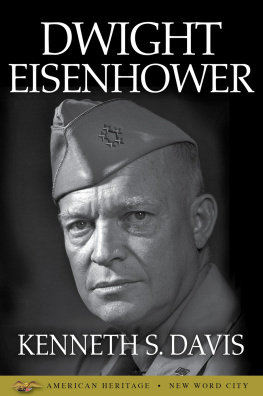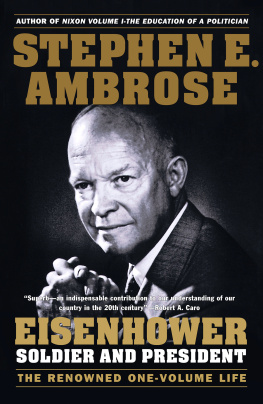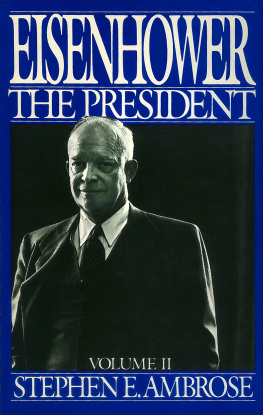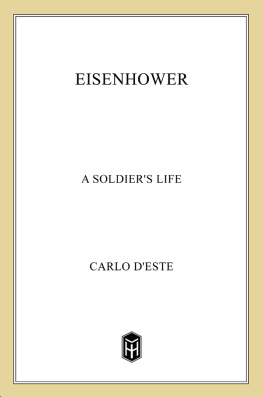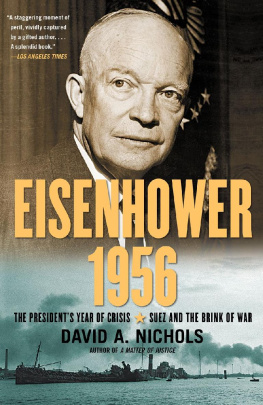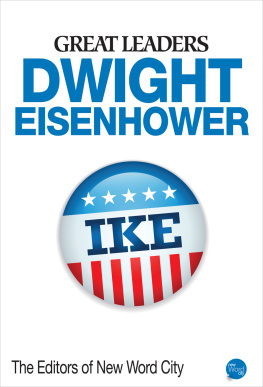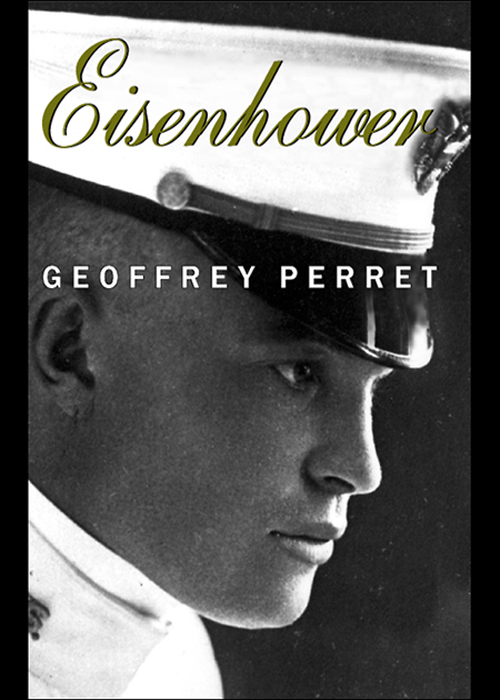
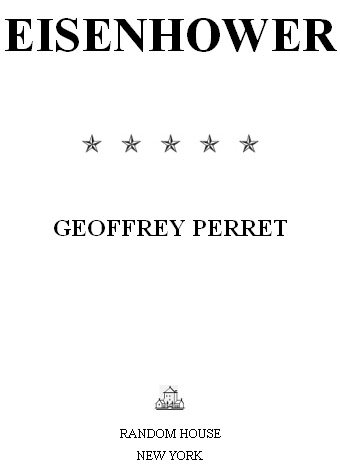
CONTENTS
This book is dedicated to
John and Carol Nalbandian
Hank and Jo Royer
Victoria Paige and Earl Levine
Kansas wouldnt be the same without them
ACKNOWLEDGMENTS
My debts begin with Stephen Ambrose, whose two-volume biography of Dwight Eisenhower, published in 1983, was a landmark work. This was the first scholarly and authoritative account of Eisenhowers life and, for me, an inspiration. Since its publication, however, a great deal of new primary material has become available. Moreover, there are by now dozens of scholarly studies that have provided, in nearly every instance, valuable new insights into Eisenhowers extraordinary abilities as both a military commander and as a President. These, combined with the new primary material, justify a fresh look at a man whom Americans trusted as they have trusted no President since.
It has been my great good fortune to have been able to talk at length with John S. D. Eisenhower, who has been as gracious as he has been helpful. His dispassionate yet affectionate insights into his fathers life have been invaluable.
I would also like to thank two members of Eisenhowers White House staff, General Andrew J. Goodpaster and Henry Roemer McPhee, both of whom found the time to talk to me despite being remarkably busy men.
I am deeply indebted to the staff at the Eisenhower Library in Abilene, and especially to its director, Dan Holt; to the deputy director, Matthew Teasley; and to the archivist assigned to help me on my numerous visits there, Herb Pankratz. At the Truman Library, in Independence, Missouri, Dennis Bilger, a man famous for his encyclopedic knowledge of that librarys holdings, was a tremendous help.
At the Manuscript Division of the Library of Congress, I have benefited from the skills and knowledge of Mary Wolfskill and Jeffrey M. Flannery. In researching this book, as in researching others, I was helped at the U.S. Military Academy by Alan Aimone, Judith Sibley and Suzanne Kristoff, leaving me in their debt once again.
I was aided, too, by Dr. Richard Summers and his assistant, David Keogh, at the U.S. Army Military Institute, a truly unique institution.
To Dr. Daun van Ee, one of the editors of the superb Papers ofDwight D. Eisenhower, I owe an immense debt of gratitude. He provided me with an invaluable insight into the forthcoming final volumes and, as if that were not enough, he read the entire manuscript for accuracy, thereby enabling me to correct various errors.
Finally, if not redundantly, I must express my gratitude yet again to my editor, Robert D. Loomis. I know that I am not alone in my admiration. Nearly everyone who has had the benefit of his skills seems to have arrived at the same conclusionwe are immeasurably lucky to have Bob Loomis edit our work.
D. Dwight Eisenhower
Under a starless sky that heaved and cracked, every crash of thunder that broke over Denison, Texas, that October night rolled down the broad valley of the Red River, shaking the cheap little clapboard houses plunked down beside the steel tracks that followed the rivers course. Typical homes of the working poorthe gandy dancers and engine wipersthey were as deficient in plumbing as they were in charm, infernally hot in the summer, grimy with soot, their white paint scarred by cinders. On the Denison side of the fast-flowing Red stretched the monotonously dull landscape of northern Texas. Across the river was an even bleaker expanse of southern Oklahoma, scoured year round by strong winds that stunted the trees and blew the topsoil away. And inside one of the dingy houses, Ida Stover Eisenhower was giving birth as lightning flashed to Earth. The sound of thunder and the pelting rain drowned the mewling of the baby as it emerged into the world and the umbilical cord was cut.
Even as she cradled the helpless pink creature in her arms, Ida couldnt help fearing for what might become of him, her third son. A deeply religious woman, she saw meaning all around her. There had to be something different about a life that began in the melodrama of such a tremendous storm. She asked herself, Wouldnt a child born to lightning flashes and cataclysmic thunder be drawn, as it grew, into a life of violence?
Several days later she opened the family Bible, pen in hand. Birth certificates were rare in frontier towns. The usual record of a new birth was kept by the family, and Ida now wrote a fresh entry: D. Dwight Eisenhower, born October 14, 1890.
This should have been a joyous moment, for her and for her husband, David Jacob Eisenhower, but whatever joy there was in it was clouded not only by Idas anxieties about the meaning of the storm but by the failure of their early prospects and youthful hopes. Since their marriage five years earlier, this young couple had fallen a long way to find themselves living in this cramped house, this dull blue-collar town.
The first Eisenhowers had arrived in America more than 150 years earlier, as members of the Mennonite sect. They had settled in and around Lancaster, Pennsylvania, the domain of the Amish. Sects breed more sects, and after a while there was an offshoot of the Mennonites who opted for total immersion and took to baptizing believers in the Susquehanna River. They became known as the River Brethren. Like their Mennonite forebears, they were pious and industrious farmers. The men made the decisions, handled the money, wore patriarchal beards and went bareheaded, because men were the glory of God. That made women inglorious in comparison, a point reinforced by making them wear large black bonnets when they left the house.
In 1878 most of the River Brethren, who by this time numbered around five hundred, decided to move west and resettle in Kansas. Just why they chose to move a thousand miles isnt altogether clear, but Kansas was bound to appeal to people like them. It was a firmly moral place, and about to set a moral standard for the nation, if not the world.
Kansas Territory had been settled by New England abolitionists in the 1850s to prevent it entering the Union as a slave state. The slavocracy fought back by sending in its own settlers. Fanaticism on both sides rehearsed the slaughter of the Civil War, making Bloody Kansas a name synonymous with terrorism, even if it was in a good cause.
After the Civil War, with slavery finally defeated, Kansas remained different. Being more moral than the rest is a habit hard to shake, and it didnt take long for a new struggle to emerge. Kansas became the cradle of the Prohibition movement and its doughtiest champion was Carry Nation, a small, bespectacled, middle-aged divorce formerly married to a drunk.
This firebrand from Enterprise, a hamlet a few miles from Abilene, was a direct action, antidrink crusader who cast fear into the hearts of burly barkeepers, the kind of men who could throw even the biggest, most aggressive drunks into the street without bothering to untie their aprons first. She liked to show up unannounced, dressed in blacklike a widowbrandishing a hatchet in one hand and a Bible in the other, usually at an hour when the saloon was likely to be filled with sinners bellying up to the bar, clutching heavy glasses, puffing on three-cent stogies and pausing now and then to wipe the beer foam from their whiskers.
Going after the beer barrels with her hatchet and the souls of the soused with choice quotations from the Good Book, Carry Nation held Kansas politicians in thrall, inspired right-thinking editors to extol her as morality on the march and made baffled workingmen complain they were being picked on by tub-thumping old maids who were too ugly to catch a man.
Next page

